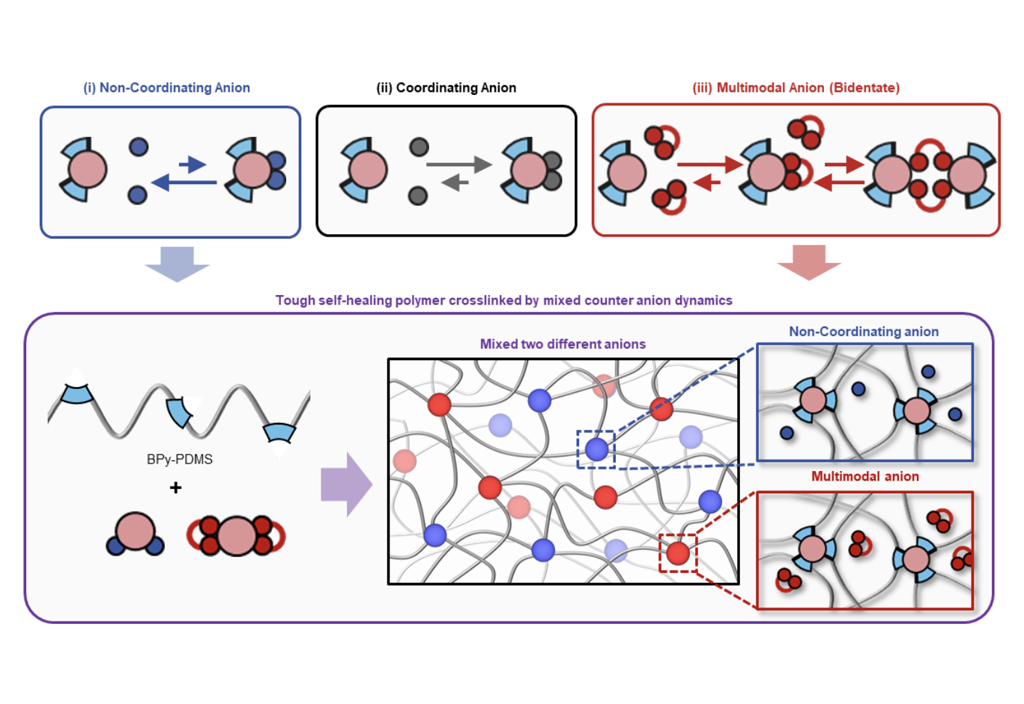Prof. Jiheong Kang’s group at KAIST has unveiled a new design strategy for coordination based self-healing polymers that simultaneously improves both mechanical properties and self-healing efficiency. This strategy put emphasis on the effect of the counter anions on the coordination environment. Metal–ligand coordination is one prominent example of dynamic bonding which undergoes reversible bond breaking and reformation, thus providing self-healing capability to the material. Since the primary role of the counter anion is to maintain charge balance around the metal centers, the effect of counter anions are often overlooked. Through detailed and systematic investigation on the different types of counter anions, the counter anion-dependent macroscopic mechanical properties and the stress relaxation mechanism of the self-healing polymer has been disclosed. More intriguingly, significant enhancement of both mechanical toughness (> 3 fold) and self-healing efficiency was observed by simply mixing two different types of counter anions with discrete functions. The study was published on 18 August, 2023 (Toughening self-healing elastomer crosslinked by metal–ligand coordination through mixed counter anion dynamics. Nat. Commun. 14, 5026 (2023)).
“Since self-healing polymers consist of dynamic and weak interactions, it has been really challenging to improve mechanical properties and self-healing efficiency at the same time. We have discovered a new approach to overcome this trade-off relationship between toughness and self-healing, which provides new insight into the design and synthetic implementation of tough and self-healing materials.” said Jiheong Kang, the corresponding author and a professor in the Department of Materials Science and Engineering at KAIST.
Stretchable and soft polymers are of great interest due to its wide applicability to the emerging fields including wearable electronics, soft robotics, and bioimplantable devices. In order for such electronic devices to operate without being damaged for a long time, it is necessary to develop soft polymeric materials that are stretchable, tough, and capable of self-healing. However, the intrinsic nature of self-healing soft polymers makes it challenging to develop the polymer with both high mechanical toughness and self-healing efficiency.
“We found that the counter anion greatly impacts the macroscopic mechanical properties of self-healing polymer crosslinked by metal–ligand coordination. Five different counter anions are categorized in 3 classes, non-coordinating anion, coordinating anion, and multimodal anion. Non-coordinating anions increase stretchability yet reduce stiffness, while coordinating anions increase stiffness but decrease stretchability. The multimodal anions induce diversification of stress relaxation mechanism, so that it relatively increases both stretchability and stiffness. The surprising thing is that multimodal and non-coordinating anions have significant synergistic effect that can improve both toughness and self-healing efficiency at the same time” Prof. Kang said.
“The underlying mechanism illustrating toughening mechanism of self-healing polymer has not been investigated in detail. Our approach to unveiling the detailed mechanism of the counter anions provides a new strategy showing the synergistic effect of the counter anions that overcomes the tread-off relationship between mechanical toughness and self-healing efficiency.,” said the first author Hyunchang Park a postdoctoral fellow in the Department of Materials Science and Engineering at KAIST and now a postdoctoral fellow at Stanford University. “We envisioned that our strategy provides a new insight into the development of tough self-healing polymer”

Prof. Jiheong Kang, Dr. Hyunchang Park Dept. of Materials Science and Engineering, KAIST
E-mail: jiheongkang@kaist.ac.kr
Homepage: https://www.jiheongkanglab.com






